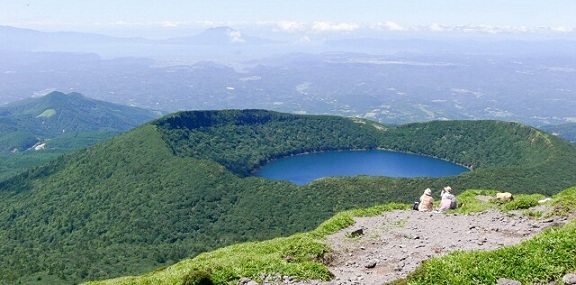
Kirishima offers everything from hiking and mountain climbing to a portal whereby you can travel back in time to Japan's mythical "Age of the Gods."
-
01
Kirishima-Yaku National Park(霧島屋久国立公園)
Kirishima-Yaku National Park is a huuuuuuge park – think Yosemite huge – and there’s no way to cover every aspect of it in a list so forgive my brevity. This park is one of the best hiking destinations in all of Japan because of the diversity of nature and wildlife.
![Kirishima-Yaku National Park]()
Kirishima-Yaku National Park
![]()
![]()
There are mountains, volcanoes, onsen, prairies, forests, lakes, rivers, and a deep connection to birth of Japanese national identity through Shinto. You can find the highest crater lakes above sea level here and the azalea bloom in early summer lights up the mountains and plains. In addition to onsen goers who come here to relax and get away from it all, many families in Kyushu have traditional cottage homes here – often with private onsen incorporated into the house design.
![Kirishima-Yaku National Park]()
Kirishima-Yaku National Park
-
02
Kirishima Shrine(霧島神宮)
Kirishima Shrine is a major shrine and it commemorates the 天孫降臨 tenson korin, an episode of the Japanese creation myth wherein the grandson of the sun goddess, Amaterasu, came to earth. He gave Japan rice and would eventually establish the imperial family. The story is recorded the earliest works of “Japanese history,” the Kojiki and Nihon Shoki, and until quite recently was central to the imperial family’s claim to legitimacy and divine lineage. At the peak of the mountain there is giant spear stuck in the earth, said to have been placed there by the god so that he would never have to use it again symbolizing peace in Japan. Every November 11th, the shrine holds the Fire of the Gods Festival at this sacred site.
-
03
Kirishima Open Air Museum(霧島アートの森)
The Kirishima Open Air Museum lies 700 meters above sea level at the base of Mt. Kirishima. It has an indoor gallery with rotating exhibitions, but the museum’s main attraction is the permanent outdoor collection – all of which was custom made by artists specifically for the museum with the intention of blending in with the surrounding terrain and nature. Many famous artists from Japan and around the world are featured including Yoko Ono.
![Kirishima Open Air Museum]()
Kirishima Open Air Museum
-
04
Senri-ga-taki Waterfall(千里ヶ滝)
Whether you choose to hike through the Kirishima mountains or drive through them, one of the most stunning sights is the Senri-ga-taki Waterfall. There are quite a few waterfalls in the mountains, but this is biggest. The allure of the falls, the awesome rushing sound resonating through the forest, and dense beauty of the forest makes it quite evident why the early Japanese associated this area with the gods. Definitely don’t forget your camera.
![Senri-ga-taki Waterfall]()
Senri-ga-taki Waterfall
-
05
Takaya no Yama no e no Misasagi(高屋山上陵)
The term 陵 misasagi is only used for imperial graves.However, until 1945 the imperial family had claimed descent from the most powerful Shinto deity, the sun goddess Amaterasu. This grave is part of a trio of funerary mounds dedicated to the divine father (Ugayafukiaezu), grandfather (Hoori), and great grandfather (Ninigi) of the first emperor, Jinmu. Although, only Hoori’s grave is in Kirishima, all 3 burial mounds are in Kagoshima Prefecture. Takaya no Yama no e no Misasagi is Hoori’s grave. He was a god of cereals, rice in particular. Ninigi, the first god to common down from the heavens to live on earth and bring order to humanity, and his grave is called 可愛山陵 E no Yama no Misasagi. Ugayafukiaezu, the father of the first emperor, lies at 吾平山上陵 Aira no Yama no Ue no Misasagi.
-
06
Uenohara Jomon Forest(上野原縄文の森)
The Uenohara Jomon Forest is an archaeological park and museum dedicated to a 9,500 year old village. You can see how Japan’s hunter-gatherer inhabitants lived and worked during the Jomon Period (14,000 BCE-300 BCE). The park has extensive restorations and a large collection of artifacts unearthed during excavations in 1997. Docents give tours with detailed explanations about the life and technologies of these prehistoric people. If you’re a history buff, this is a must see destination. That said, you might want to consider getting your own guide or interpreter as the site isn’t quite 100% English friendly yet, though most staff can communicate in very basic English.
Posts by Marky StarHana no Onsen Hotel Ginsyo
Yunohama 5-26-29 Ibusuki Kagoshima

- Kirishima Open-Air Museum
-
4.5
83 Reviews -
-
- Kagoshima Pref. Airagunyusuichou Koba 6340-220
-
-
-
- 0995745945
-
-
-
- 9:00-17:00 (Reception until …
-
View All- Uenohara Jomon no Mori Park
-
-
- Kagoshima Pref. Kirishimashi Kokubuenoharajoumonnomori 1-1
-
-
-
- 0995485701
-
-
-
- [Exhibition hall] 9:00-17:00…
-
View All -







 Go here
Go here












